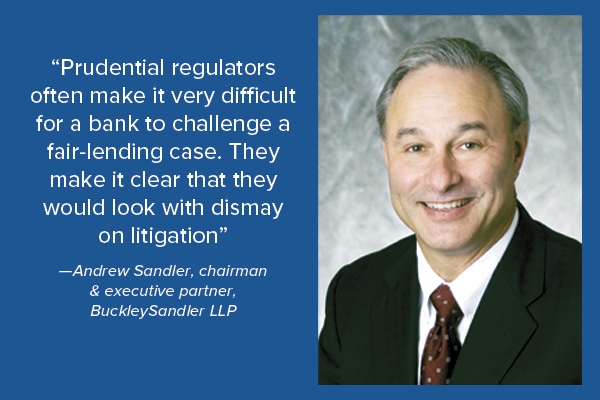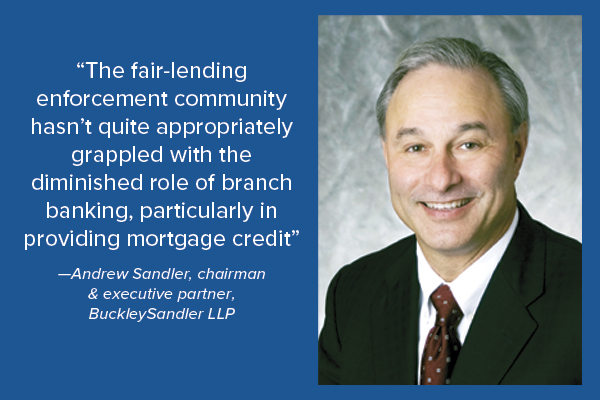Fair lending from a veteran’s perspective
Andrew Sandler has seen it all, and looks ahead as fair-lending evolves
- |
- Written by Steve Cocheo
 How will the upcoming election affect fair-lending enforcement? Expert Andrew Sandler addresses that in the course of an exclusive interview.
How will the upcoming election affect fair-lending enforcement? Expert Andrew Sandler addresses that in the course of an exclusive interview.
For about a quarter century now, marked first by the settlement in the 1992 Decatur Federal Savings case and as recently as June’s BancorpSouth Bank consent decree, fair-lending law has been a prime item on the banking industry’s radar. Through all that time attorney Andrew Sandler has been in the thick of it, working with banks under investigation or embroiled in cases where some variation of fair-lending violation has been alleged.
Fair-lending investigation and litigation has been an evolving legal area, dominated for most of that quarter century by the Justice Department and its developing ways of evaluating banks’ performance.
Justice’s techniques of choice have changed over the years. Along the way, one of the most significant, and most controversial wrinkles was adoption of the disparate impact approach to fair-lending enforcement. This expanded from the traditional evaluation of disparate treatment—outright discrimination in lending—to encompass unintentional discriminatory effect on minorities or other protected groups. This legal theory does not require the Justice Department nor private plaintiffs to prove intent to discriminate, only the apparent resulting discriminatory result.
Sandler and his current firm, BuckleySandler LLP, wrote an analysis attacking this theory on behalf of the American Bankers Association in 2012. Yet, the theory has survived attempts to unseat it, culminating in the Supreme Court decision to uphold disparate impact in the Texas Department of Housing and Community Affairs v. The Inclusive Communities Project, Inc.

Now there are two gorillas
While the Court’s decision continues to affect the industry, Sandler has been in the trenches as fair-lending enforcement has continued to evolve.
“There used to be one 800-pound gorilla in the fair-lending room, the Justice Department,” said Sandler, chairman and executive partner at the law firm and also CEO of Treliant Risk Advisors. “Now there are two 800-pound gorillas, Justice and the Consumer Financial Protection Bureau.”
In an interview with Banking Exchange, Sandler noted that the two government entities don’t always have the same focus in fair-lending. But they both keep on working at this issue, and they have learned to cooperate.
“The Justice Department is pursuing as many matters as it ever has, and in fact has more redlining investigations underway than ever before,” said Sandler. “CFPB also has investigations underway. CFPB has focused its resources on indirect auto lending, but as the bureau shifts from that, we’ll see a lot more fair-lending activity looking at a broad cross section of other issues.”
Sandler says these areas include credit cards and student lending, as well as an issue a bit further out, but coming: small business lending. In a recent presentation during ABA’s Regulatory Compliance Conference, Sandler noted that while expanded data reporting on small business credit remains under development at the bureau, CFPB examiners will be delving into small business credit in order to further develop the bureau’s understanding of the issues there.
Sandler told bankers this was a good opportunity to educate bureau staff, which could help improve the eventual reporting rules. Many questions remain regarding what kinds of loans will be considered small business credit—one example likely to come into the net are small business credit cards.
CFPB’s involvement in fair-lending enforcement goes beyond having more eyes on the matter. During his ABA presentation, Sandler drew a sports-based analogy to explain the significance of the bureau’s involvement.
“Think of CFPB as an umpire,” Sandler said. “Now, the rules say that a strike is a strike and a ball is a ball. What do umpires and baseball leagues do when hitters are killing pitchers? They expand the strike zone.”
What this means is that as CFPB broadens its fair-lending focus, it will affect how current definitions are interpreted and how statistics are evaluated.
Dealing with two players
Does that mean banking will become a wishbone, pulled between Justice and CFPB?
“There is not a lack of consistency in the approaches that Justice and CFPB take,” Sandler said in the interview. “It’s just that they may focus on different issues and concerns.”
At the bank level, when an institution becomes the subject of an investigation, the difference may be felt.
“At Justice, there’s a playbook that’s developed over time,” said Sandler. “On the other hand, CFPB is still feeling its way. So working with the bureau is a little more complicated and difficult because it is still working out what its overall approach is going to be.”
Banking Exchange interviewed Sandler in his Washington offices. The comments in this article have been edited for flow and clarity.
Q. We’re in the midst of a hotly contested election, with two candidates that approach many issues very differently. The Decatur case occurred during the era of President George H.W. Bush, a Republican. How will fair-lending enforcement potentially be affected by this election?
A. Let me speak generally first. The Justice Department’s fair-lending agenda is to prevent fair-lending discrimination and it will continue to do that under any administration. Justice has been doing that for 25 years.
CFPB is here to stay. There may be nuances from administration to administration in the ways that agencies pursue their mandate, but CFPB’s mandate is to protect against unfair and deceptive practices and discrimination, and it will continue to do that under any administration.
More specifically, at Justice a change in administration could result in significant changes in philosophy. That, and the appointment of a new Assistant Attorney General for Civil Rights, could create some changes. Historically, we haven’t seen a great deal of change because much of the career staff remains the same. But sometimes the types of cases that Justice brings change.
At CFPB you’ve got an independent agency where the director serves a five-year term. [Editor’s note: Richard Cordray’s term expires in the summer of 2018.] But the current approach has been embedded with permanent staff, so I would expect CFPB to largely stay the course.
The biggest potential change would be in regard to the aggressive use of the disparate impact theory. A new administration might require the Justice Department to act in a manner more consistent with the Supreme Court’s admonitions on how the disparate impact theory can be used.
At the prudential bank regulators, I don’t expect a lot of change. They have been doing fair lending since 1992, through Democratic and Republican administrations.
Overall, I see the mainstream “meat and potatoes” aggressive enforcement continuing. The more aggressive theories I can see an administration backing away from. For example, I would expect to see the indirect auto lending initiative lose steam. It’s just too aggressive and I don’t think a new administration would be comfortable with it. And there may be more rigor on how statistics are used to form a prima facie case. [Editor’s note: The term is defined as “accepted as correct until proved otherwise.”]
Q. What about the controversial “BISG” technique that CFPB uses as a proxy for determining an individual’s race and other demographic data when dealing with credit types where lenders are not permitted to gather this data directly? [BISG stands for “Bayesian Improved Surname Geocoding.” The methodology has played a key role in indirect auto lending cases, such as the 2013 Ally Financial case.]
A. CFPB internal memos leaked to the media indicate that the bureau has had significant doubts about BISG, but that it will continue to use that method until there’s something better. The Justice Department view is that it will use it until there’s something better. My own view is that the method is so fundamentally flawed that law enforcement should not be making any decisions based on it.
If we ever got to federal court on its validity, I feel reasonably confident that no court would accept evidence based on BISG.
Q. But it seems like none of these fair-lending cases ever get to court.
A. Some cases have made it to court. But you have to understand that almost all of the fair-lending cases have been against banks. The prudential regulators often make it very difficult for a bank to challenge a fair-lending case. They make it clear that they would look with dismay on litigation. For example, regulators may downgrade them until the case is resolved. Examination results can be held in abeyance until the case is resolved. There are lots of pressure points, and it very difficult for banks to not decide to put it all behind them.
Nobody wants to litigate with the Justice Department, but nonbanks don’t have the same constraints. Quicken Loans was prepared to litigate. [Editor’s note: Its countersuit was dismissed last year]. It’s unlikely you would have seen a bank litigate that case. I think at some point you will see a fair-lending case go to court when a deep-pocketed nonbank decides to fight back, in some situation where the government is way over its skis.
Q. Speaking of nonbanks, in May the Treasury Department issued its report on marketplace lending, where it stated, “While data-driven algorithms may expedite credit assessments and reduce costs, they also carry the risk of disparate impact in credit outcomes and the potential for fair-lending violations.” But there haven’t been any cases yet…
A. It’s a brave new world. I don’t think the regulators have quite gotten their hands around how to deal with marketplace lending. There has been a significant over-investment in federal fair-lending resources at both the CFPB and the Justice Department in indirect auto lending. I think they’re likely to be redeploying those resources in the reasonable near term. And when they do I would expect that alternative financial services will see more aggressive fair-lending scrutiny.

Q. Something I don’t understand about the Hudson City settlement and some other cases is the emphasis on branches, with the banks sometimes having to agree to open more branches in majority minority and other neighborhoods as part of the settlement. With branches, the subject more often is whether they still serve a purpose.
A. The fair-lending enforcement community hasn’t quite appropriately grappled with the diminished role of branch banking, particularly in providing mortgage credit to consumers. And they continue to very much over-value the presence of a bank in particular places as a way to assess a bank’s commitment.
That’s a real problem and it’s a heavy education burden for financial institutions subjected to examination. The regulators will come to understand why bank branching is not really all that relevant in many circumstances but they’re not there yet.
Q. What about the intersection of fair lending with UDAAP?
A. Whenever UDAAP comes into play, when there’s an allegation that consumers are treated unfairly, it is not infrequent that the consumers who suffer are disproportionately minorities. So one would expect that there will be any number of UDAAP claims that are also fair-lending claims.
Q. How does a bank stay out of fair-lending trouble today?
A. All you can do is work hard to do the right thing. Treat your customers fairly and treat all of your customers the same way so that you’re not subject to protected-class fair-lending issues or to UDAAP issues.
But there are no magic bullets.
And because the agencies—particularly CFPB—take very aggressive views, there will be times when lenders believe that they’re operating in a fair and nondiscriminatory manner, and the agencies may take a different point of view.
So all banks can do is work to stay on top of the guidances, the consent decrees, and other information coming out of Washington. They can do their best to understand what the agencies’ issues are. Consistent with business needs they must conduct their business in a way that doesn’t run afoul of those concerns.
Q. Are there fair-lending exposures that banks aren’t thinking about?
A. I’m not sure that all banks understand the magnitude of Washington’s concern over limited access to credit and the resulting implications for the rigor with which we are going to see redlining and underwriting investigations. Underwriting investigations will focus on denial disparity rates, which is something we really haven’t seen a whole lot of since the 1990s.
Something else that people are not as focused on as they should be is the Military Lending Act, when combined with the Service Member Civil Relief Act. I view that as a fair-lending matter because I consider the active military as essentially another protected class, even though they have separate statutes that protect them. We’re seeing lots and lots of investigations and cases around lending to military personnel and their dependents.
Tagged under Compliance, Fair Lending, Feature, Feature3,













